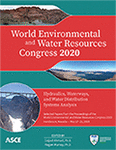World Environmental and Water Resources Congress 2020
Improved Adaptive Immersed Boundary Method for Smooth Wall Shear
Publication: World Environmental and Water Resources Congress 2020: Hydraulics, Waterways, and Water Distribution Systems Analysis
ABSTRACT
Immersed boundary (IB) method has been extensively researched and used due to its advantage of simulating flow over complex and moving objects in rivers. However, for high Reynolds number flows, it is still a challenge to produce correct and smooth wall shear stress that is essential for sediment transport. This challenge comes from the non-uniform wall distance of IB cell center and the discontinuous wall functions in boundary layers. Specifically, when the background grid is fixed and the immersed boundary geometry is arbitrary, the distance from IB cell center to immersed boundary is non-uniform. Also, the distance to its image point, which is generally proportional to the distance of IB cell center, has the same non-uniformity and the image point may be located in the log-law layer or laminar layer. However, in many existing IB method, there are two discontinuous wall functions in these two boundary layers. As a result, the shear velocity may be estimated with image points and different wall functions, which gives a non-smooth wall shear distribution. Moreover, some of these distances are extremely small, resulting in numerical instability and even divergence. In this work, an improved treatment is proposed where the image point distance is set to be proportional to the size of IB cell, which produces a more uniform and stable distribution of the distance. Consequently, all image points are able to be in the log-law layer and follow the same wall function to provide smooth wall shear stress. This IB method has been implemented in the U2 RANS code. Cases in 1D and 2D are shown.
Get full access to this article
View all available purchase options and get full access to this chapter.
REFERENCE
Balaras, E. (2004). Modeling complex boundaries using an external force field on fixed Cartesian grids in large-eddy simulations. Computers & Fluids, 33(3), 375-404.
Harada, M., Tamaki, Y., Takahashi, Y., & Imamura, T. (2016). A Novel Simple Cut-Cell Method for Robust Flow Simulation on Cartesian Grids. In 54th AIAA Aerospace Sciences Meeting (p. 0601).
Kalitzin, G., & Iaccarino, G. (2002). Turbulence modeling in an immersed-boundary RANS method. CTR Annual Briefs, 415-426.
Kim, J., Kim, D., & Choi, H. (2001). An immersed-boundary finite-volume method for simulations of flow in complex geometries. Journal of computational physics, 171(1), 132-150.
Lai, Y. G., Weber, L. J., and Patel, V. C. (2003). “Nonhydrostatic three dimensional method for hydraulic flow simulation. I: Formulation and verification.” J. Hydraul. Eng., 129(3), 196–205.
Launder, B. E., & Spalding, D. B. (1983). The numerical computation of turbulent flows. In Numerical prediction of flow, heat transfer, turbulence and combustion (pp. 96-116). Pergamon.
Mittal, R., & Iaccarino, G. (2005). Immersed boundary methods. Annu. Rev. Fluid Mech., 37, 239-261.
Peskin, C. (1973). Flow patterns around heart valves: a digital computer method for solving the equations of motion. IEEE Transactions on Biomedical Engineering, (4), 316-317.
Pitz, R. W., & Daily, J. W. (1981, January). Experimental study of combustion in a turbulent free shear layer formed at a rearward facing step. In 19th Aerospace Sciences Meeting (p. 106).
Pu, T. M., & Zhou, C. H. (2018). An immersed boundary/wall modeling method for RANS simulation of compressible turbulent flows. International Journal for Numerical Methods in Fluids, 87(5), 217-238.
Roman, F., Napoli, E., Milici, B., & Armenio, V. (2009). An improved immersed boundary method for curvilinear grids. Computers & fluids, 38(8), 1510-1527.
Seo, J. H., & Mittal, R. (2011). A high-order immersed boundary method for acoustic wave scattering and low-Mach number flow-induced sound in complex geometries. Journal of computational physics, 230(4), 1000-1019.
Silva, A. L. E., Silveira-Neto, A., & Damasceno, J. J. R. (2003). Numerical simulation of two-dimensional flows over a circular cylinder using the immersed boundary method. Journal of Computational Physics, 189(2), 351-370.
Sotiropoulos, F., & Yang, X. (2014). Immersed boundary methods for simulating fluid–structure interaction. Progress in Aerospace Sciences, 65, 1-21.
Tessicini, F., Iaccarino, G., Fatica, M., Wang, M., & Verzicco, R. (2002). Wall modeling for large-eddy simulation using an immersed boundary method. Annual Research Briefs, 181-187.
Wieghardt, K., & Tillmann, W. (1951). On the turbulent friction layer for rising pressure.
Information & Authors
Information
Published In
World Environmental and Water Resources Congress 2020: Hydraulics, Waterways, and Water Distribution Systems Analysis
Pages: 119 - 128
Editors: Sajjad Ahmad, Ph.D., and Regan Murray, Ph.D.
ISBN (Online): 978-0-7844-8297-1
Copyright
© 2020 American Society of Civil Engineers.
History
Published online: May 14, 2020
Published in print: May 14, 2020
Authors
Metrics & Citations
Metrics
Citations
Download citation
If you have the appropriate software installed, you can download article citation data to the citation manager of your choice. Simply select your manager software from the list below and click Download.
